Epitaxy of (11–22) AlN Films on a Sputtered Buffer Layer with Different Annealing Temperatures via Hydride Vapour Phase Epitaxy
Abstract
:1. Introduction
2. Materials and Methods
3. Results and Discussion
4. Conclusions
Author Contributions
Funding
Institutional Review Board Statement
Informed Consent Statement
Data Availability Statement
Conflicts of Interest
References
- Khan, A.; Balakrishnan, K.; Katona, T. Ultraviolet light-emitting diodes based on group three nitrides. Nat. Photonics 2008, 2, 77–84. [Google Scholar] [CrossRef]
- Khan, F.; Ajmal, H.M.S.; Nam, K.; Kim, S.-D. Enhancement in the photonic response of ZnO nanorod–gated AlGaN/GaN HEMTs with N2O plasma treatment. Opt. Express 2020, 28, 27688–27701. [Google Scholar] [CrossRef] [PubMed]
- Masui, H.; Nakamura, S.; DenBaars, S.P.; Mishra, U.K. Nonpolar and Semipolar III-Nitride Light-Emitting Diodes: Achievements and Challenges. IEEE Trans. Electron Devices 2010, 57, 88–100. [Google Scholar] [CrossRef]
- Ranalli, F.; Parbrook, P.J.; Bai, J.; Lee, K.B.; Wang, T.; Cullis, A.G. Non-polar AlN and GaN/AlN on r-plane sapphire. Phys. Status Solidi C 2009, 6, S780–S783. [Google Scholar] [CrossRef]
- Wu, J.-J.; Katagiri, Y.; Okuura, K.; Li, D.-B.; Miyake, H.; Hiramatsu, K. Effects of initial conditions and growth temperature on the properties of nonpolar a -plane AlN grown by LP-HVPE. Phys. Status Solidi C 2009, 6, s478–s481. [Google Scholar] [CrossRef]
- Monavarian, M.; Rashidi, A.; Feezell, D. A Decade of Nonpolar and Semipolar III-Nitrides: A Review of Successes and Challenges. Phys. Status Solidi A 2019, 216, 1800628. [Google Scholar] [CrossRef]
- Mogilatenko, A.; Kirmse, H.; Stellmach, J.; Frentrup, M.; Mehnke, F.; Wernicke, T.; Kneissl, M.; Weyers, M. Analysis of crystal orientation in AlN layers grown on m-plane sapphire. J. Cryst. Growth 2014, 400, 54–60. [Google Scholar] [CrossRef]
- Nagamatsu, K.; Liu, X.; Uesugi, K.; Miyake, H. Improved emission intensity of UVC-LEDs from using strain relaxation layer on sputter-annealed AlN. Jpn. J. Appl. Phys. 2019, 58, Sccc07. [Google Scholar] [CrossRef]
- Lahnemann, J.; Den Hertog, M.; Hille, P.; de la Mata, M.; Fournier, T.; Schormann, J.; Arbiol, J.; Eickhoff, M.; Monroy, E. UV photosensing characteristics of nanowire-based GaN/AlN superlattices. Nano Lett. 2016, 16, 3260–3267. [Google Scholar] [CrossRef]
- Wunderer, T.; Chua, C.L.; Northrup, J.E.; Yang, Z.; Johnson, N.M.; Kneissl, M.; Garrett, G.A.; Shen, H.; Wraback, M.; Moody, B.; et al. Optically pumped UV lasers grown on bulk AlN substrates. Phys. Status Solidi C 2021, 95, 822–825. [Google Scholar] [CrossRef]
- Burenkov, A.; Matthus, C.D.; Erlbacher, T. Optimization of 4H-SiC UV Photodiode Performance Using Numerical Process and Device Simulation. IEEE Sens. J. 2016, 16, 4246–4252. [Google Scholar] [CrossRef]
- Aldalbahi, A.; Li, E.; Rivera, M.; Velazquez, R.; Altalhi, T.; Peng, X.; Feng, P.X. A new approach for fabrications of SiC based photodetectors. Sci. Rep. 2016, 6, 23457. [Google Scholar] [CrossRef]
- Jung, S.-W.; Shin, M.-C.; Schweitz, M.A.; Oh, J.-M.; Koo, S.-M. Influence of Gas Annealing on Sensitivity of AlN/4H-SiC-Based Temperature Sensors. Materials 2021, 14, 683. [Google Scholar] [CrossRef]
- Akasaka, T.; Kobayashi, Y.; Makimoto, T. Growth of nonpolar AlN (11) and (100) films on SiC substrates by flow-rate modulation epitaxy. Appl. Phys. Lett. 2007, 90, 121919. [Google Scholar] [CrossRef]
- Boichot, R.; Chen, D.; Mercier, F.; Baillet, F.; Giusti, G.; Coughlan, T.; Chubarov, M.; Pons, M. Epitaxial Growth of AlN on (0001) Sapphire: Assessment of HVPE Process by a Design of Experiments Approach. Coatings 2017, 7, 136. [Google Scholar] [CrossRef]
- Okada, N.; Kato, N.; Sato, S.; Sumii, T.; Fujimoto, N.; Imura, M.; Balakrishnan, K.; Iwaya, M.; Kamiyama, S.; Amano, H.; et al. Epitaxial lateral overgrowth of a-AlN layer on patterned a-AlN template by HT-MOVPE. J. Cryst. Growth 2007, 300, 141–144. [Google Scholar] [CrossRef]
- Boichot, R.; Claudel, A.; Baccar, N.; Milet, A.; Blanquet, E.; Pons, M. Epitaxial and polycrystalline growth of AlN by high temperature CVD: Experimental results and simulation. Surf. Coat. Technol. 2010, 205, 1294–1301. [Google Scholar] [CrossRef]
- Pons, M.; Boichot, R.; Coudurier, N.; Claudel, A.; Blanquet, E.; Lay, S.; Mercier, F.; Pique, D. High temperature chemical vapor deposition of aluminum nitride, growth and evaluation. Surf. Coat. Technol. 2013, 230, 111–118. [Google Scholar] [CrossRef]
- Hagedorn, S.; Knauer, A.; Mogilatenko, A.; Richter, E.; Weyers, M. AlN growth on nano-patterned sapphire: A route for cost efficient pseudo substrates for deep UV LEDs. Phys. Status Solidi A 2016, 213, 3178–3185. [Google Scholar] [CrossRef]
- Iba, Y.; Shojiki, K.; Uesugi, K.; Xiao, S.; Miyake, H. MOVPE growth of AlN films on nano-patterned sapphire substrates with annealed sputtered AlN. J. Cryst. Growth 2020, 532, 125397. [Google Scholar] [CrossRef]
- Yusuf, Y.; Samsudin, M.; Sahar, M.M.; Hassan, Z.; Maryam, W.; Zainal, N. High quality aluminum nitride layer grown with a combined step of nitridation and trimethylaluminum preflow. Thin Solid Films 2021, 736, 138915. [Google Scholar] [CrossRef]
- Jinno, D.; Otsuki, S.; Sugimori, S.; Daicho, H.; Iwaya, M.; Takeuchi, T.; Kamiyama, S.; Akasaki, I. Characterization and optimization of sputtered AlN buffer layer on r-plane sapphire substrate to improve the crystalline quality of nonpolar a-plane GaN. J. Cryst. Growth 2017, 480, 90–95. [Google Scholar] [CrossRef]
- Miyake, H.; Nishio, G.; Suzuki, S.; Hiramatsu, K.; Fukuyama, H.; Kaur, J.; Kuwano, N. Annealing of an AlN buffer layer in N2–CO for growth of a high-quality AlN film on sapphire. Appl. Phys. Express 2016, 9, 025501. [Google Scholar] [CrossRef]
- Uesugi, K.; Miyake, H. Fabrication of AlN templates by high-temperature face-to-face annealing for deep UV LEDs. Jpn. J. Appl. Phys. 2021, 60, 120502. [Google Scholar] [CrossRef]
- Jo, M.; Itokazu, Y.; Kuwaba, S.; Hirayama, H. Improved crystal quality of semipolar AlN by employing a thermal annealing technique with MOVPE. J. Cryst. Growth 2019, 507, 307–309. [Google Scholar] [CrossRef]
- Itokazu, Y.; Kuwaba, S.; Jo, M.; Kamata, N.; Hirayama, H. Influence of the nucleation conditions on the quality of AlN layers with high-temperature annealing and regrowth processes. Jpn. J. Appl. Phys. 2019, 58, Sc1056. [Google Scholar] [CrossRef]
- Walde, S.; Hagedorn, S.; Weyers, M. Impact of intermediate high temperature annealing on the properties of AlN/sapphire templates grown by metalorganic vapor phase epitaxy. Jpn. J. Appl. Phys. 2019, 58, Sc1002. [Google Scholar] [CrossRef]
- Uedono, A.; Shojiki, K.; Uesugi, K.; Chichibu, S.F.; Ishibashi, S.; Dickmann, M.; Egger, W.; Hugenschmidt, C.; Miyake, H. Annealing behaviors of vacancy-type defects in AlN deposited by radio-frequency sputtering and metalorganic vapor phase epitaxy studied using monoenergetic positron beams. J. Appl. Phys. 2020, 128, 085704. [Google Scholar] [CrossRef]
- Chen, L.; Lin, W.; Chen, H.; Xu, H.; Guo, C.; Liu, Z.; Yan, J.; Sun, J.; Liu, H.; Wu, J.; et al. Annihilation and Regeneration of Defects in (11-22) Semipolar AlN via High-Temperature Annealing and MOVPE Regrowth. Cryst. Growth Des. 2021, 21, 2911–2919. [Google Scholar] [CrossRef]
- Li, D.-D.; Chen, J.-J.; Su, X.-J.; Huang, J.; Niu, M.-T.; Xu, J.-T.; Xu, K. Preparation of AlN film grown on sputter-deposited and annealed AlN buffer layer via HVPE. Chin. Phys. B 2021, 30, 036801. [Google Scholar] [CrossRef]
- Xiao, S.; Jiang, N.; Shojiki, K.; Uesugi, K.; Miyake, H. Preparation of high-quality thick AlN layer on nanopatterned sapphire substrates with sputter-deposited annealed AlN film by hydride vapor-phase epitaxy. Jpn. J. Appl. Phys. 2019, 58, Sc1003. [Google Scholar] [CrossRef]
- Huang, J.; Niu, M.; Sun, M.; Su, X.; Xu, K. Investigation of hydride vapor phase epitaxial growth of AlN on sputtered AlN buffer layers. CrystEngComm 2019, 21, 2431–2437. [Google Scholar] [CrossRef]
- Xiao, S.; Shojiki, K.; Miyake, H. Thick AlN layers grown on micro-scale patterned sapphire substrates with sputter-deposited annealed AlN films by hydride vapor-phase epitaxy. J. Cryst. Growth 2021, 566–567, 126163. [Google Scholar] [CrossRef]
- Nakanishi, Y.; Hayashi, Y.; Hamachi, T.; Tohei, T.; Nakajima, Y.; Xiao, S.; Shojiki, K.; Miyake, H.; Sakai, A. Micro- and Nanostructure Analysis of Vapor-Phase-Grown AlN on Face-to-Face Annealed Sputtered AlN/Nanopatterned Sapphire Substrate Templates. J. Electron. Mater. 2023, 52, 5099–5108. [Google Scholar] [CrossRef]
- Miyake, H.; Lin, C.-H.; Tokoro, K.; Hiramatsu, K. Preparation of high-quality AlN on sapphire by high-temperature face-to-face annealing. J. Cryst. Growth 2016, 456, 155–159. [Google Scholar] [CrossRef]
- Tanaka, S.; Shojiki, K.; Uesugi, K.; Hayashi, Y.; Miyake, H. Quantitative evaluation of strain relaxation in annealed sputter-deposited AlN film. J. Cryst. Growth 2019, 512, 16–19. [Google Scholar] [CrossRef]
- Gu, W.; Liu, Z.; Guo, Y.; Wang, X.; Jia, X.; Liu, X.; Zeng, Y.; Wang, J.; Li, J.; Yan, J. Comprehensive study of crystalline AlN/sapphire templates after high-temperature annealing with various sputtering conditions. J. Semicond. 2020, 41, 122802. [Google Scholar] [CrossRef]
- Hagedorn, S.; Walde, S.; Mogilatenko, A.; Weyers, M.; Cancellara, L.; Albrecht, M.; Jaeger, D. Stabilization of sputtered AlN/sapphire templates during high temperature annealing. J. Cryst. Growth 2019, 512, 142–146. [Google Scholar] [CrossRef]
- Hagedorn, S.; Mogilatenko, A.; Walde, S.; Pacak, D.; Weinrich, J.; Hartmann, C.; Weyers, M. High-Temperature Annealing and Patterned AlN/Sapphire Interfaces. Phys. Status Solidi B 2021, 258, 2100187. [Google Scholar] [CrossRef]
- Bersch, B.C.; Caminal Ros, T.; Tollefsen, V.; Johannessen, E.A.; Johannessen, A. Improved Crystallinity of Annealed 0002 AlN Films on Sapphire Substrate. Materials 2023, 16, 2319. [Google Scholar] [CrossRef]
- Dinh, D.V.; Conroy, M.; Zubialevich, V.Z.; Petkov, N.; Holmes, J.D.; Parbrook, P.J. Single phase (112¯2) AlN grown on (101¯0) sapphire by metalorganic vapour phase epitaxy. J. Cryst. Growth 2015, 414, 94–99. [Google Scholar] [CrossRef]
- Stellmach, J.; Frentrup, M.; Mehnke, F.; Pristovsek, M.; Wernicke, T.; Kneissl, M. MOVPE growth of semipolar (112) AlN on m-plane (100) sapphire. J. Cryst. Growth 2012, 355, 59–62. [Google Scholar] [CrossRef]
- Jo, M.; Morishita, N.; Okada, N.; Itokazu, Y.; Kamata, N.; Tadatomo, K.; Hirayama, H. Impact of thermal treatment on the growth of semipolar AlN on m-plane sapphire. AIP Adv. 2018, 8, 105312. [Google Scholar] [CrossRef]
- McLaurin, M.B.; Hirai, A.; Young, E.; Wu, F.; Speck, J.S. Basal Plane Stacking-Fault Related Anisotropy in X-ray Rocking Curve Widths of m-Plane GaN. Jpn. J. Appl. Phys. 2008, 47, 5429–5431. [Google Scholar] [CrossRef]
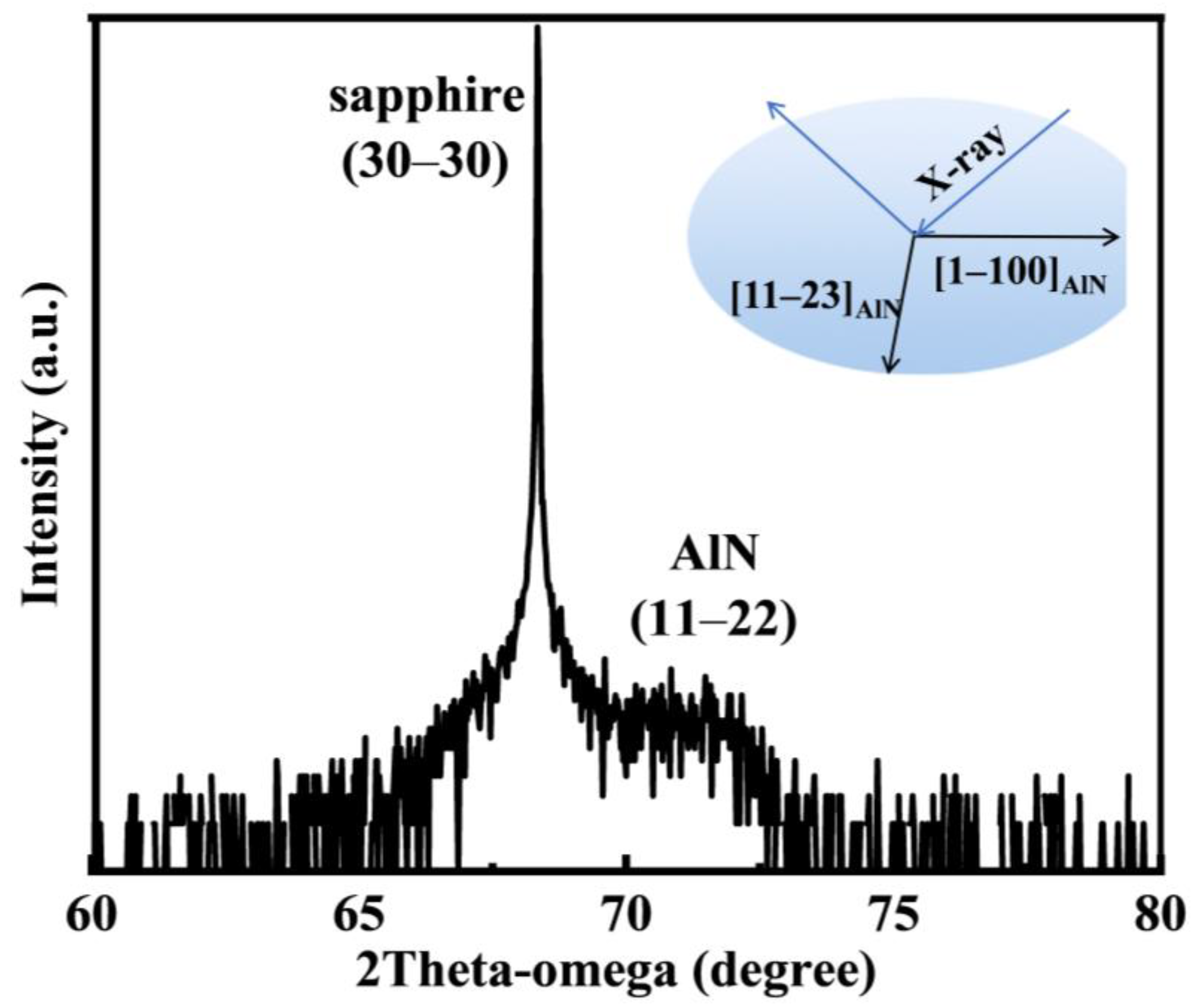
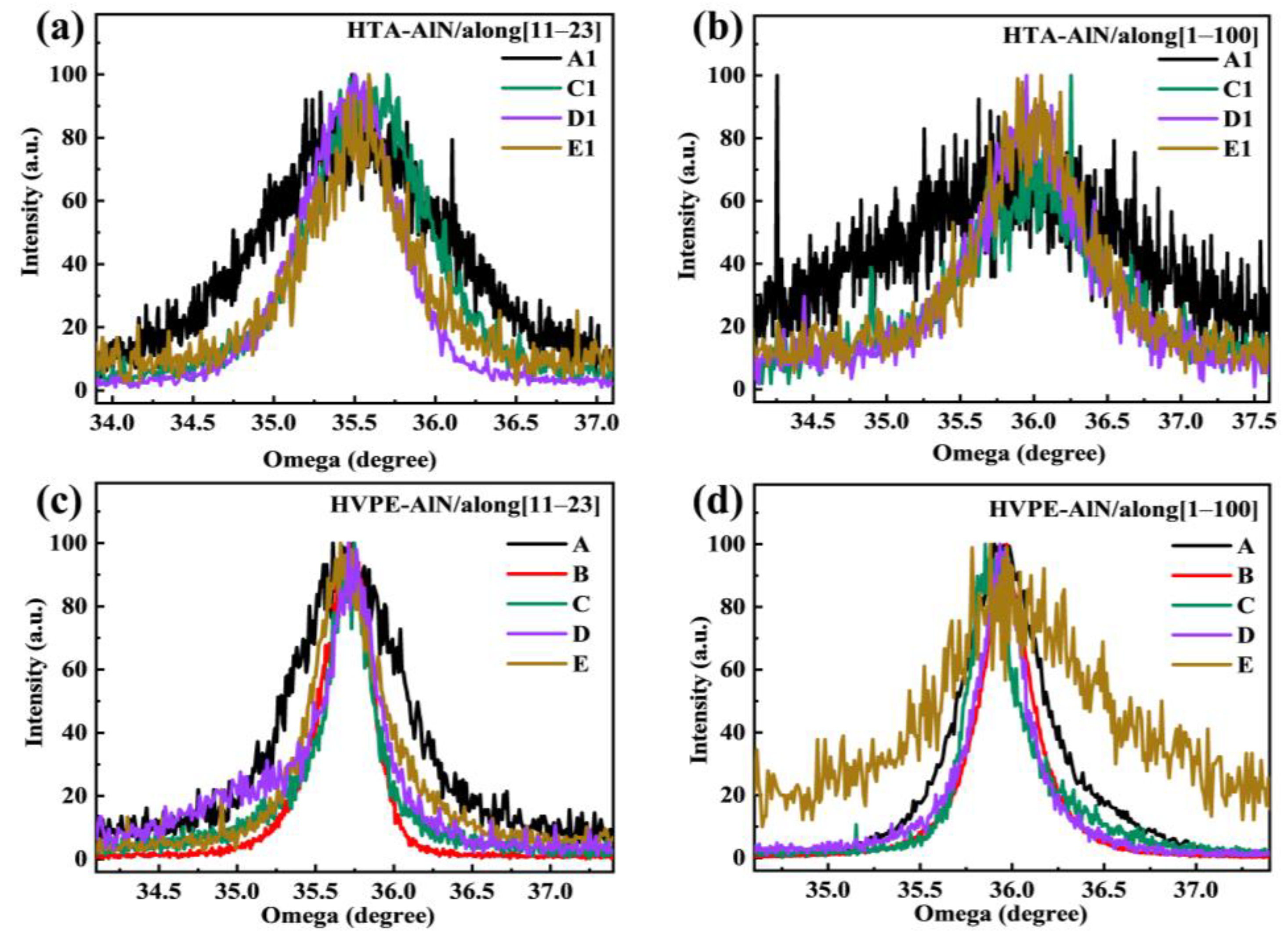
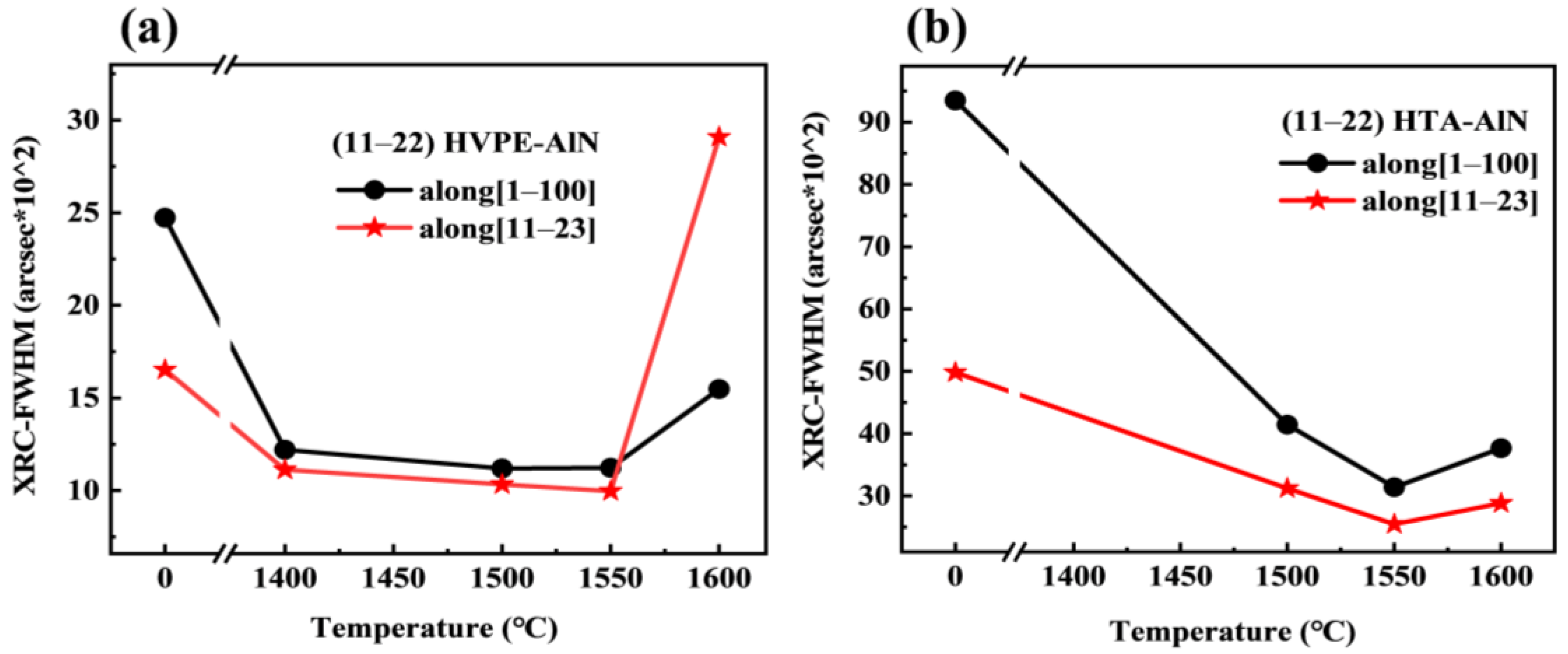
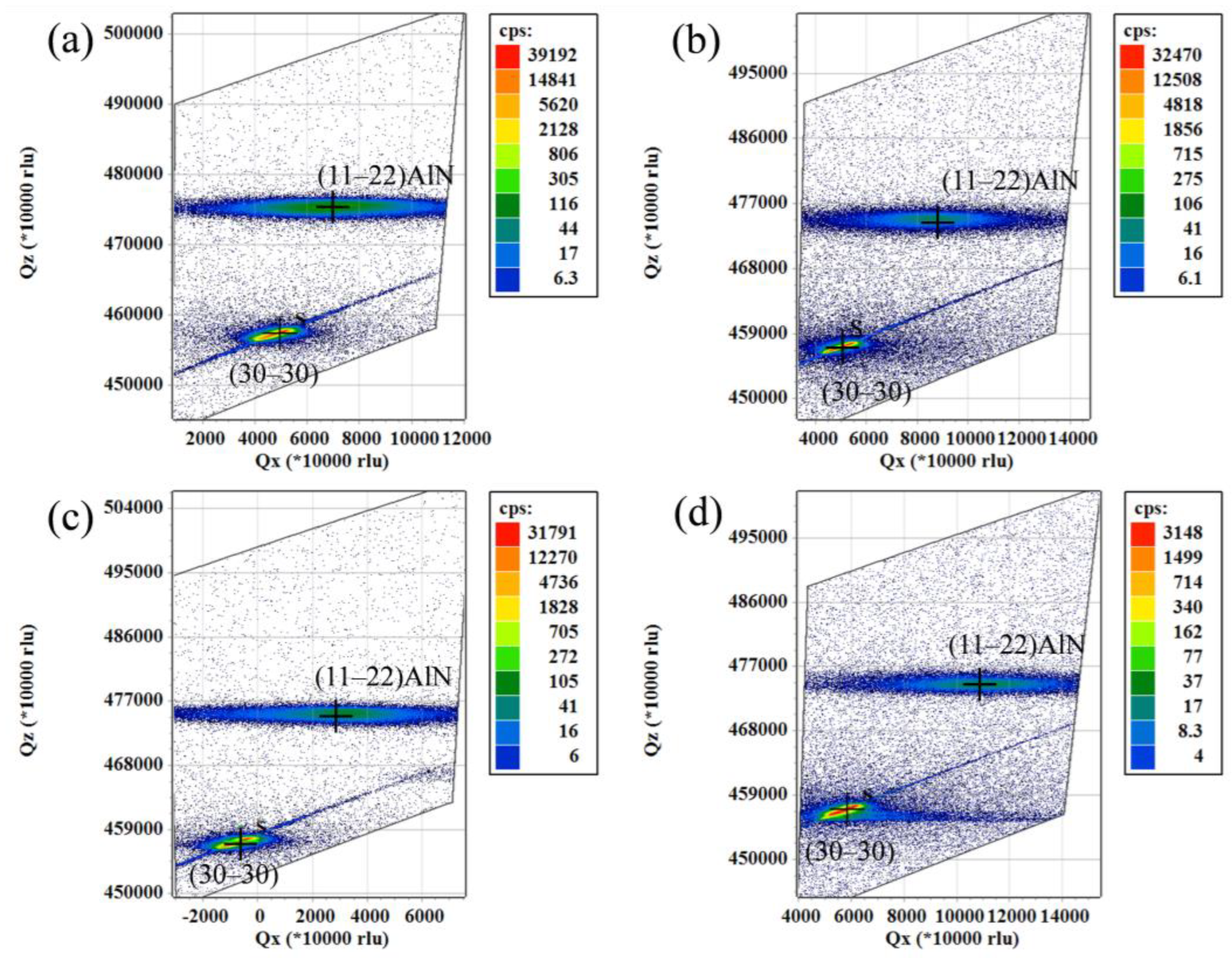
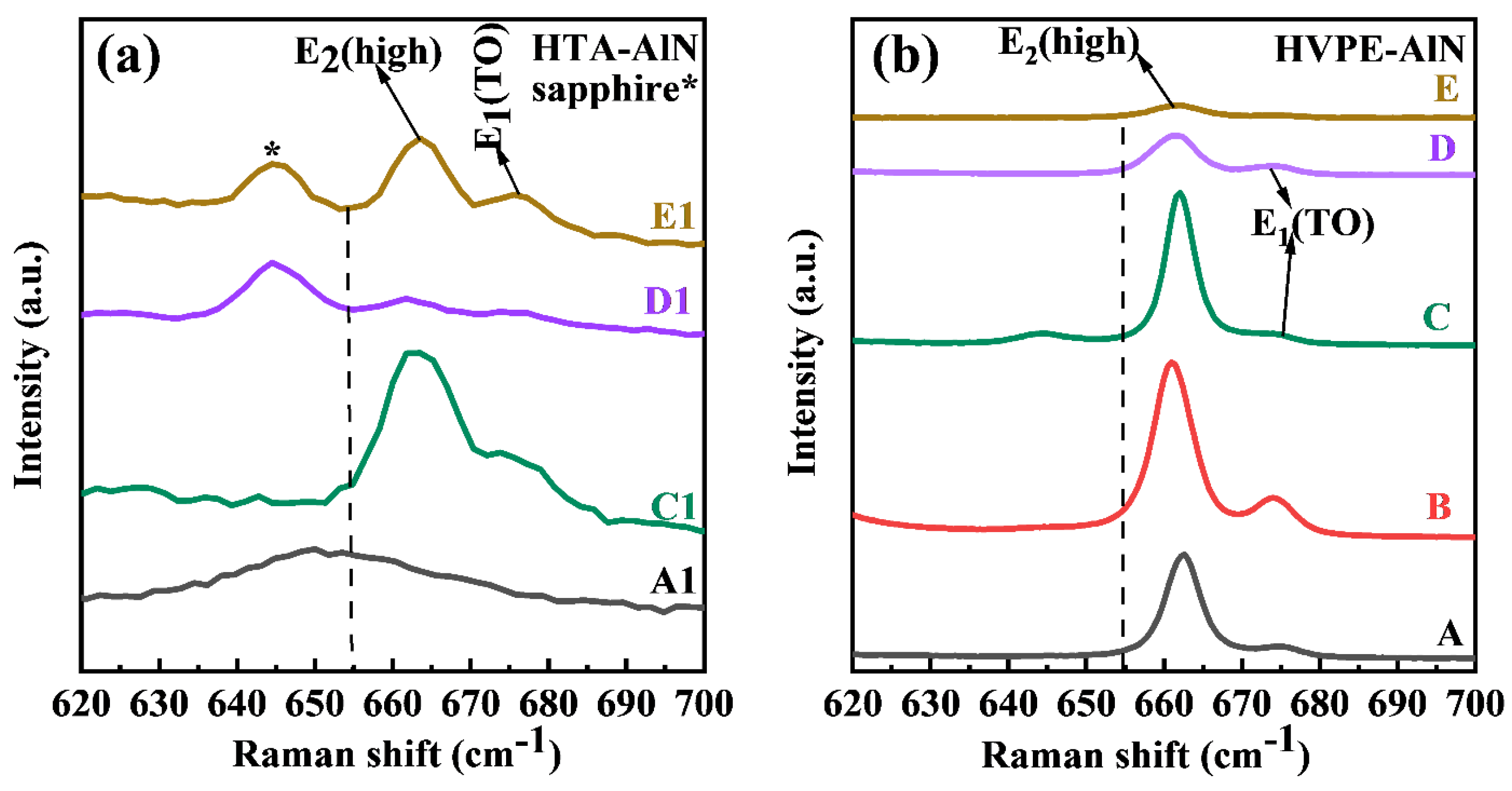


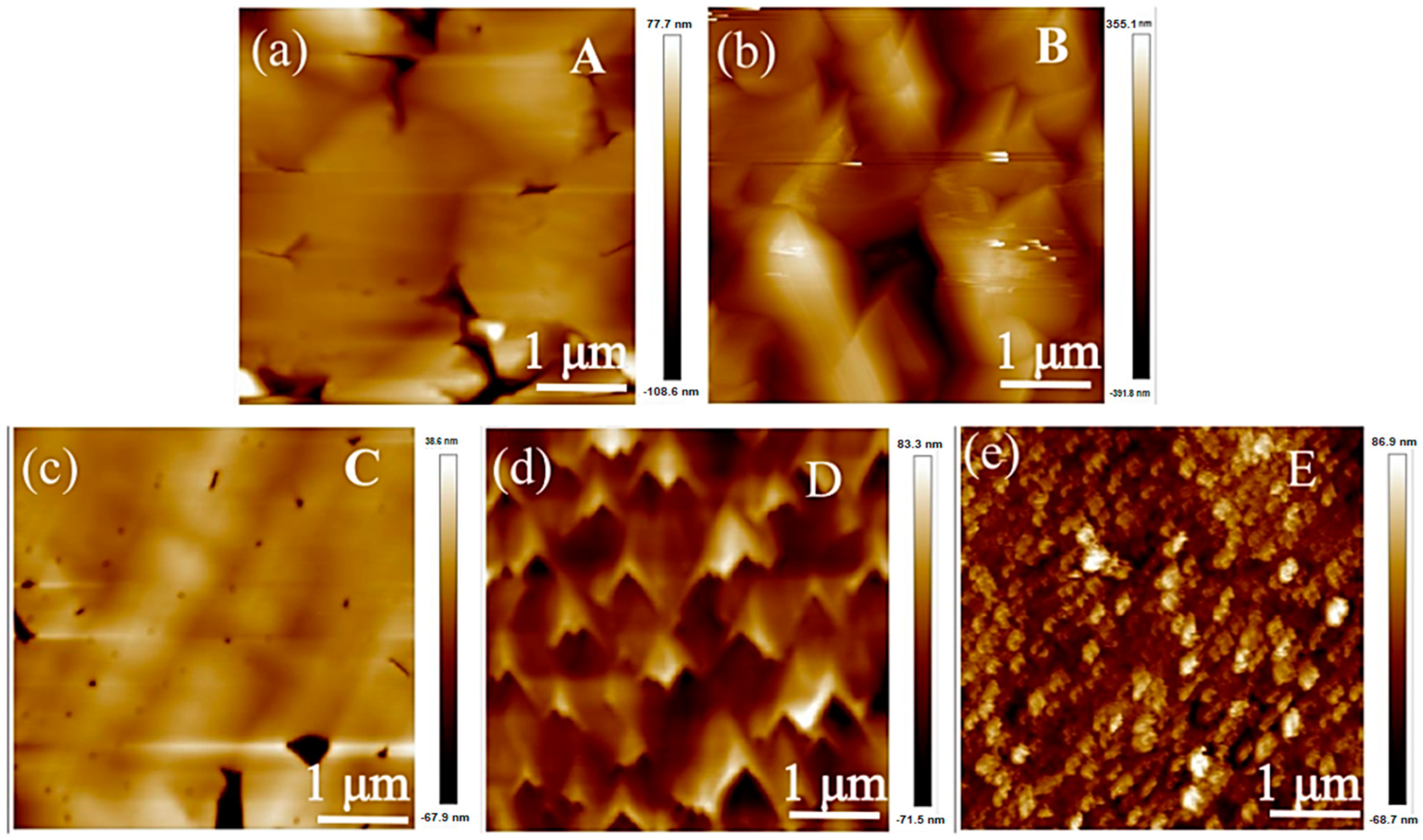

| Author References | Substrate | Sputtering Temperature (°C) | Variant | Annealing Temperature (°C) | HVPE Growth Temperature (°C) | (002) FWHM (Arcsec) | (102) FWHM (Arcsec) |
|---|---|---|---|---|---|---|---|
| Di-Di Li et al. [30] | Sapphire | 650 | V/Ⅲ | 1500 | 500 | 64 | 648 |
| Shiyu Xiao et al. [31] | NPSS | 600 | Growth temperature | 1700 | 1450–1550 | 102 | 219 |
| Jun Huang et al. [32] | Sapphire | 650 | Annealing temperature and time | 1400–1550 | 1500 | 28 | 418 |
| Shiyu Xiao et al. [33] | μPSSs | 600 | Two-step growth | 1700 | 1500–1600 | 110 | 390 |
| Yudai Nakanishi et al. [34] | NPSS | HVPE/ MOVPE | 1700 | 1500 | 4.7 × 108 cm−2 | ||
| HVPE-AlN Samples | Annealing Temperature (°C) | HTA-AlN Buffer Layer |
|---|---|---|
| A | 0 | A1 |
| B | 1400 | B1 |
| C | 1500 | C1 |
| D | 1550 | D1 |
| E | 1600 | E1 |
| w/o Annealing | 1400 °C | 1500 °C | 1550 °C | 1600 °C | |
|---|---|---|---|---|---|
| HTA MS buffer | 0.30 | -- | 0.14 | 0.10 | 0.13 |
| HVPE-AlN | 0.19 | 0.08 | 0.04 | 0.06 | 0.31 |
Disclaimer/Publisher’s Note: The statements, opinions and data contained in all publications are solely those of the individual author(s) and contributor(s) and not of MDPI and/or the editor(s). MDPI and/or the editor(s) disclaim responsibility for any injury to people or property resulting from any ideas, methods, instructions or products referred to in the content. |
© 2024 by the authors. Licensee MDPI, Basel, Switzerland. This article is an open access article distributed under the terms and conditions of the Creative Commons Attribution (CC BY) license (https://creativecommons.org/licenses/by/4.0/).
Share and Cite
Yan, X.; Sun, M.; Ji, J.; He, Z.; Zhang, J.; Sun, W. Epitaxy of (11–22) AlN Films on a Sputtered Buffer Layer with Different Annealing Temperatures via Hydride Vapour Phase Epitaxy. Materials 2024, 17, 327. https://doi.org/10.3390/ma17020327
Yan X, Sun M, Ji J, He Z, Zhang J, Sun W. Epitaxy of (11–22) AlN Films on a Sputtered Buffer Layer with Different Annealing Temperatures via Hydride Vapour Phase Epitaxy. Materials. 2024; 17(2):327. https://doi.org/10.3390/ma17020327
Chicago/Turabian StyleYan, Xuejun, Maosong Sun, Jianli Ji, Zhuokun He, Jicai Zhang, and Wenhong Sun. 2024. "Epitaxy of (11–22) AlN Films on a Sputtered Buffer Layer with Different Annealing Temperatures via Hydride Vapour Phase Epitaxy" Materials 17, no. 2: 327. https://doi.org/10.3390/ma17020327






